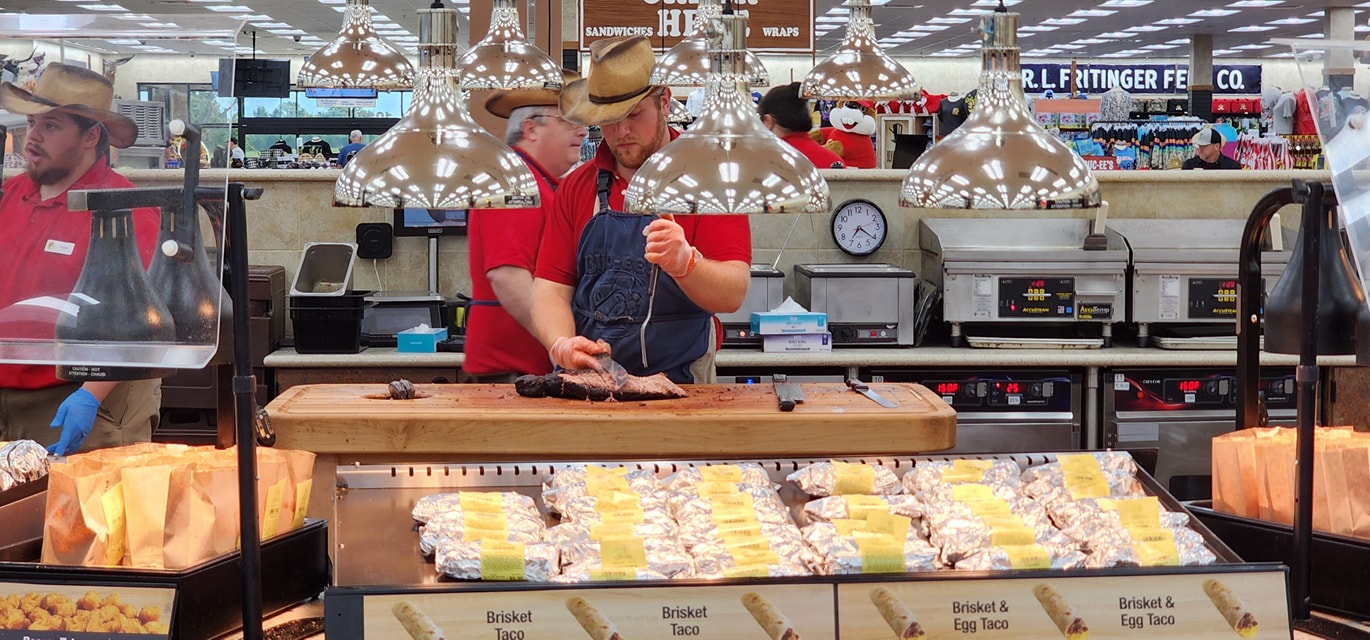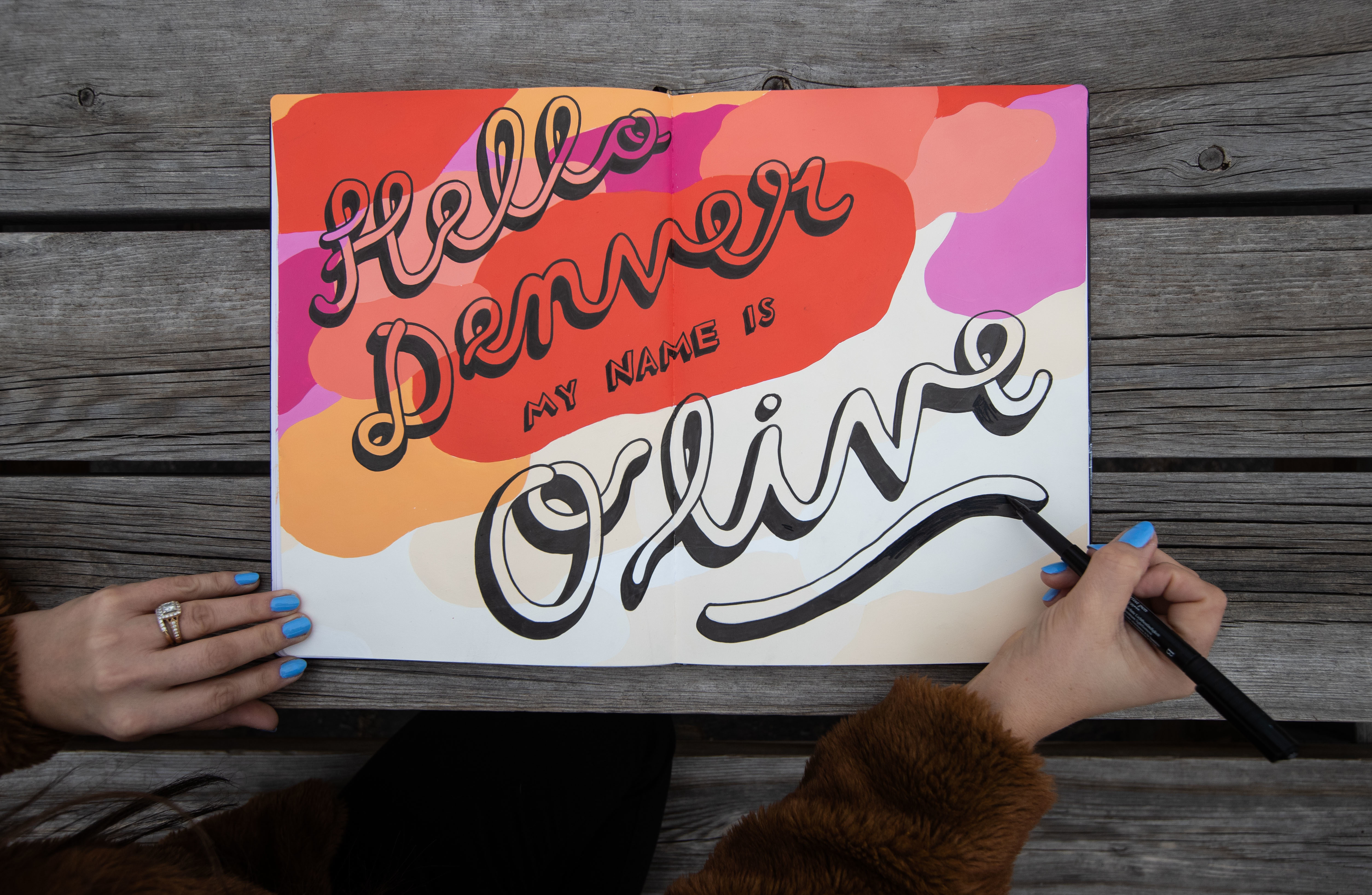Welcome to our series, Hello Denver, My Name is… where we profile people in Denver that you probably don’t know — but should. Get ready to meet painters, dancers, comedians, musicians, designers and just generally fascinating people that help make this city awesome.
Although her newer paintings and illustrations are whimsically abstract, Olive Moya earned her merits as an artist in California, filling sketchbooks with cheeky, sarcastic and socially relevant drawings. Where the forms she now paints are reminiscent of “noodles” and the sparse lettering is largely inspired by hip-hop lyrics, Moya’s early illustrations betrayed her inner angst and rebellious spirit. Now, the more matured and Colorado-based artist has over 20 filled sketchbooks and a growing number of walls adorned with her playful style. One of her murals can be found at Huckleberry Roasters on North Pecos Street and the another (a series of murals) can be found in the Lululemon at Park Meadows.
And even though the more recent paintings rely on happiness-inducing color choices and freehanded, gestural strokes, Moya still carries some remnants of the punkish youthful attitude that developed her skills and taught her how to embrace her individuality. She’s stubborn but realistic, effervescent but esoteric — and ready to take on Denver’s biggest walls.
Denver, meet Olive.
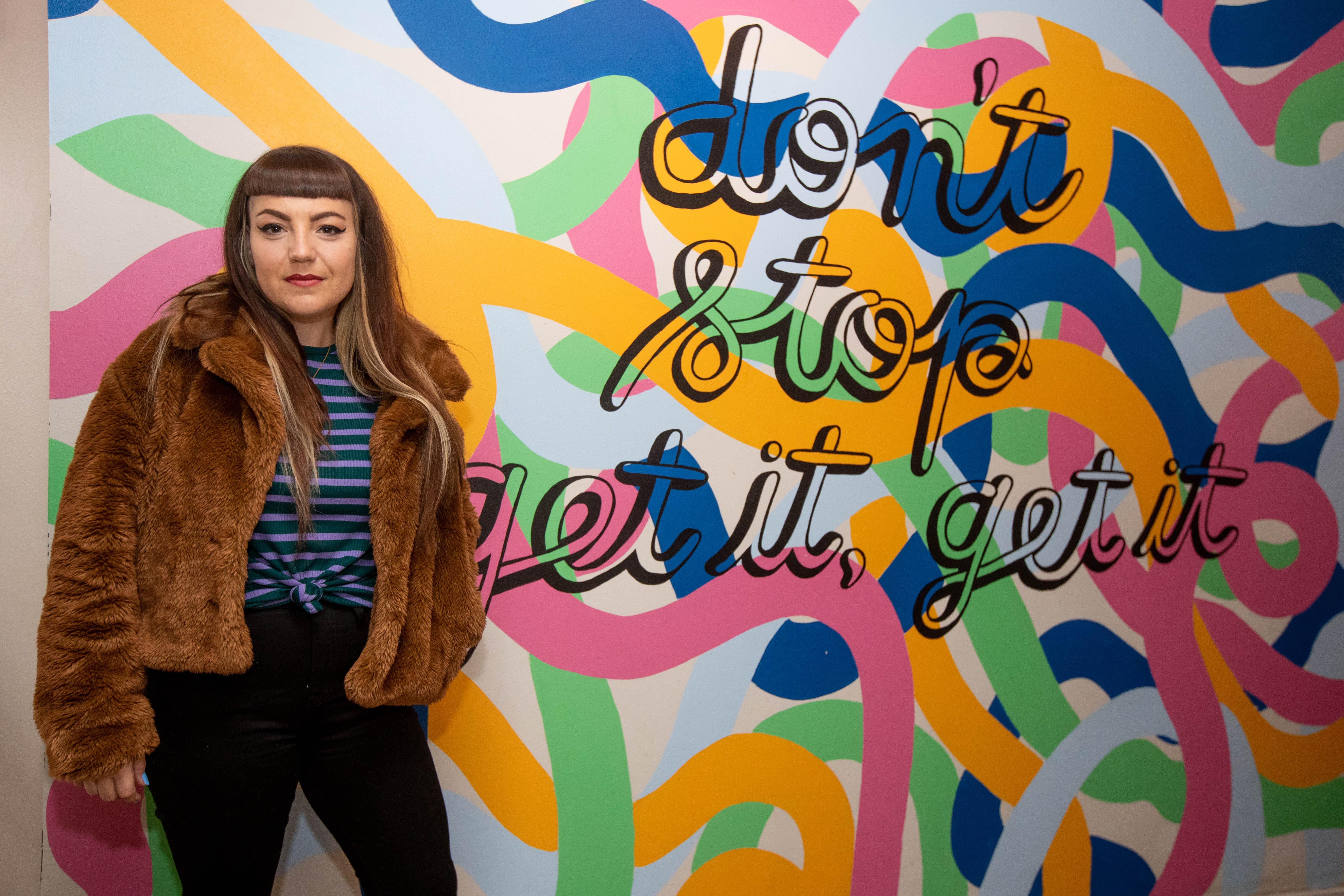
303 Magazine: When did you move to Denver, and why?
Olive Moya: Five years ago, on October 1, 2013. I hate to say this, but I didn’t know anything about Denver. I’d been to Vail one time for a wedding. But we moved because my husband got a job opportunity with his brother-in-law. I didn’t think I’d ever leave LA but it started to feel like we couldn’t have a family there or do what we really wanted to do. But moving to Denver was a happy accident. The weather is pretty nice and things have grown so much in the last five years, it’s been really fun.
303: Has your move to Denver changed the style of your work at all?
OM: Denver has softened me. Maybe LA is hard or being young was hard. I was angsty. My personality is that I’m stubborn and opinionated and I don’t think that’s a bad thing but in the beginning, I was especially extroverted [with my opinions]. In Denver, I’ve met so many people who checked that part of me, to the point I realized a lot of the things that I thought mattered don’t matter so much.
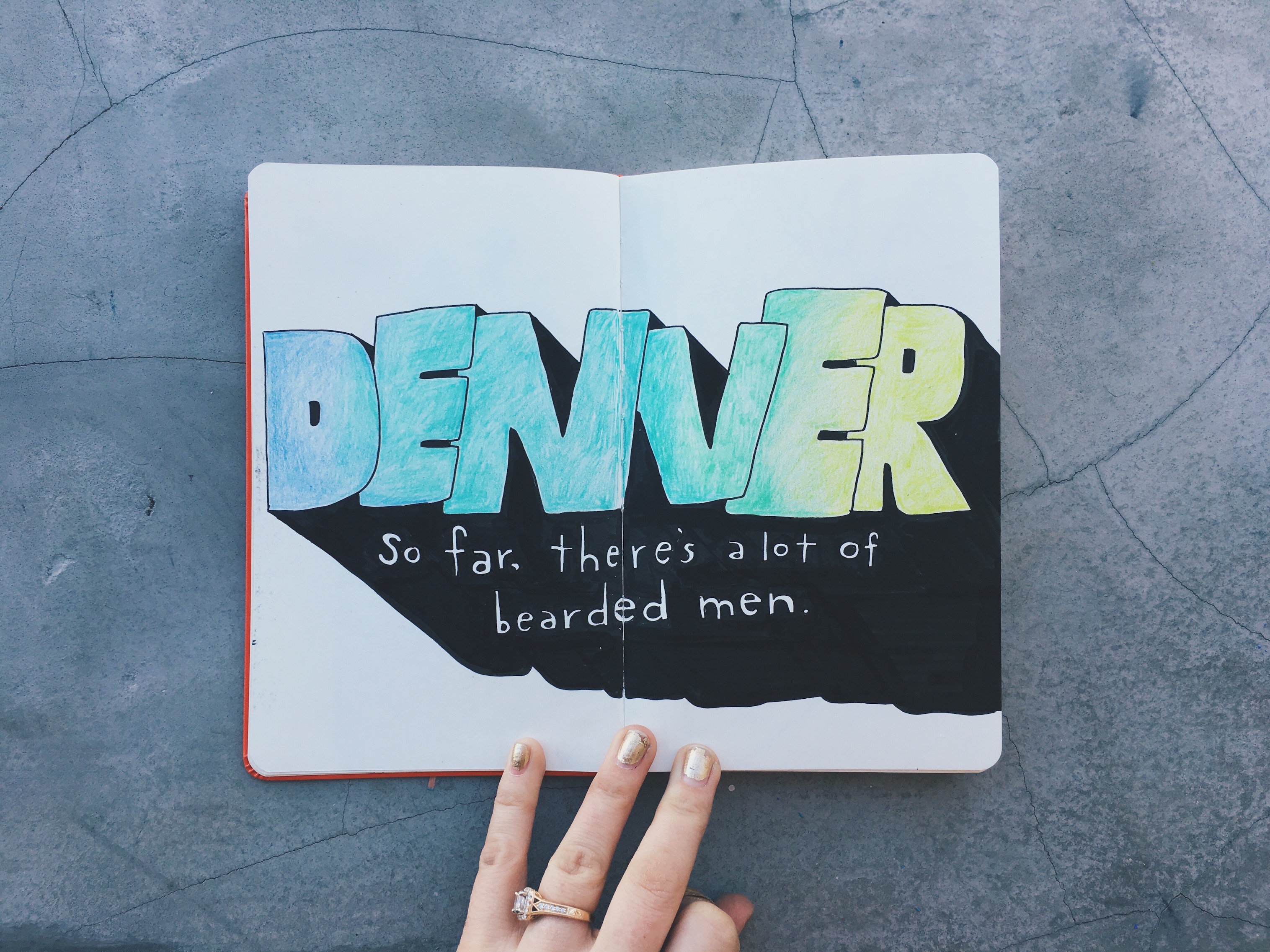
303: How would you describe the Denver art scene compared to the LA art scene, or others you’ve been a part of?
OM: There are so many artists in LA and people are more competitive. I’m a stereotypical artist, where I’d rather be at home in my pajamas, just painting — so networking was difficult. That’s why Denver is nicer. It’s smaller and it feels like people don’t want something from you all the time. LA can be pretentious, but it’s hard because you learn there is a reason for that pretention. So you perpetuate the idea that you have to be a trained professional artist in order to draw something that sells. I like that LA is super conceptual and people hold art in this really high regard. But I liked, after coming to Denver, that people didn’t feel the need to act a certain way with art [here]. Everyone is chill, there seems to be less of a hierarchy. As an artist, you need so much stimulation, or at least I feel like I do. Just going to museums and other events that make you think or feel something. At first, in Denver, it didn’t seem like all those options were here, but with time I realized you just have to look in the right places.
303: Recently, your work has taken on a different aesthetic. You mention it on your website as “noodle” forms. Can you think of a certain moment or reason why you started on the noodle path?
OM: When I was pregnant, I went to LA to see my friends and I was drawing and going to all my old places and it felt like I was forcing my own style. I had worked on it so hard, and I felt like I was losing it. I was forcing myself to do those snarky illustrations, and they weren’t turning out the way I wanted them. I started having ideas that were more color-based or abstract, and I’d do them — but then always shy away from it. When I came back from that trip, I just dove into the abstract stuff. I title them with silly, funny things and that part is still using some of my old style.
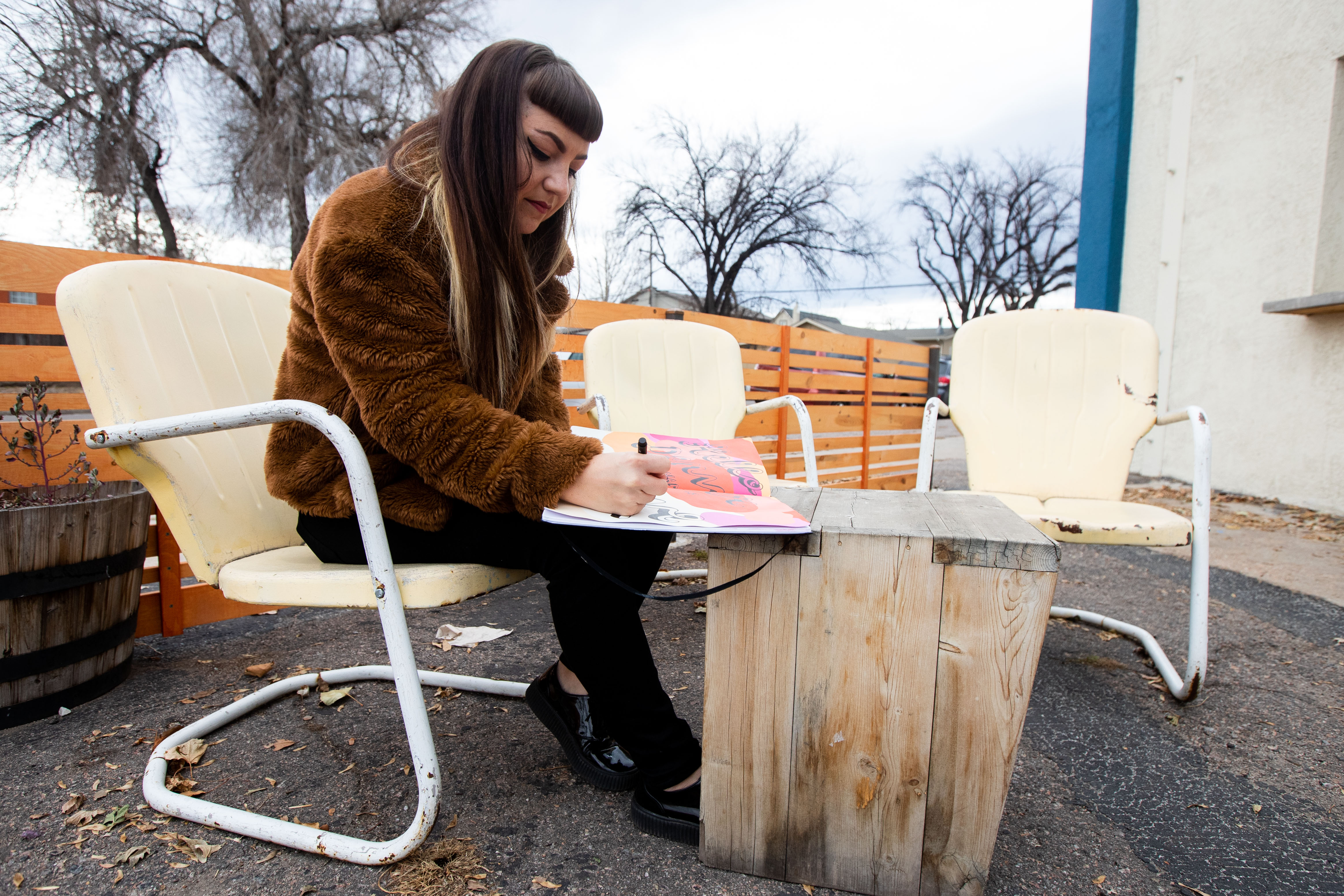
303: How would you describe your conceptual process?
OM: Well usually, it happens right before I go to bed. Or in a coffee shop. I like watching other people and the noise and I just get out of my own head a bit. I think usually it comes as a full image in my head, especially right now with the abstract work. When I was illustrating before, it was always something funny or ironic or sarcastic. It was my commentary on the world around me. It would end up commenting on all sorts of things — the subject’s identity, my identity, the culture. Now, things are more aesthetic in my brain. I think to myself — ‘it would feel good if all these noodles were tangled and then went into their own different directions.’ I just start some work not even knowing where it’s going and just feeling it out by colors as I go. I love the name of paint colors. It’s also a meditative process… since happiness isn’t a single destination.
303: You have a pretty consistent color theme at the moment. What do those colors mean to you?
OM: I guess it’s a little more intuitive. I like certain types of colors. I’m not afraid of color — I put all of them in at once. I also spend a lot of time just drawing with pen, in my sketchbooks. Then I just got this huge urge to put color onto something. Once I had the colors, I continued with them. I always use house paint and I just bought the sample sizes, so I’m still using a lot that I first bought. I’m sure when I get into a different phase of my life, my colors will change. They’re happy colors — they make me feel good. I like pastel but I also like to offset with primaries. With the Huckleberry [coffee shop] mural, they wanted me to change the red to the pink that you see now. Most of my paintings, if I feel like it’s getting too “Easter” I just put a nice, bold, primary color to offset it.
303: What are the colors of the Hello Denver sketch?
OM: I love that you asked that! The whites in the drawing are Light Nougat, Almond Milk, Night Blooming Jasmine and Coconut Twist. The reds/pinks are Florida Sunrise, Guava Jelly, Watermelon Slice, Tutti Fruitti, Pimento and High Maintenance.

303: If you could re-name your favorite color, what would you name it? (and what is the current name of that color?)
OM: My favorite colors are named: “Solarium,” “Toile Blue” and “Greek Isles.” I would name them: “Somewhere Between Death On The Sun And Pea Soup,” “The Smell Of Getting Out Of The Suburbs” and “Neapolitan Shake And Salty Hair.”
303: When did you start painting murals?
OM: My first mural, well, that was when I was around 15. My parents bought a new house [in Temecula, California] and there was an extra garage. It was going to be a hang-out space for the kids. So not even using spray paint, just using house paint, I painted what I thought looked like graffiti — of course, I lived in the suburbs so I didn’t really know [laughs]. It was there for years. Then I re-painted it right when I graduated high school with something totally different. Besides that, my senior thesis project in college was the next two murals I painted. My favorite artist for a long time was Blu, and he painted massive walls, sometimes with ‘hot topics’ or political messaging and I just loved his stuff. It has always been my dream to do a big wall like him.
303: What’s the biggest difference between a sketchbook and a wall?
OM: They feel really similar to me because a sketchbook is a final piece. I was influenced a lot in school by artists who used sketchbooks as final pieces or displayed the entire book in a gallery. So my sketchbooks, each page is special and I don’t want to mess it up. I hate when I mess up a few in a row because I’ll want to throw the whole book out or paint over the whole spread. Murals are just more fun because I like working really big. I have a heavy hand… so what I like about painting murals is that I can make big movements and marks. A sketchbook feels more intimate. Both have a ‘showing off’ aspect or a performance part. I don’t draw in my sketchbook at home, I come to a coffee shop to draw. It’s not that I want people to look at me drawing, it’s that I want to see how they experience it. Murals feel the same I guess. I love painting and having people interact with me while I do it.
303: Tell me about your “dream wall.” (i.e., the wall or surface you most want to paint a mural on right now)
OM: If it’s big, I want it. I’ve never painted with a scaffolding or lift, and I would just kill for an opportunity like that.
303: How many sketchbooks do you have that are filled (or mostly filled) with your illustrations?
OM: I have them all in an IKEA dresser, one with all the square cubbies, and my baby messes with them all the time. Anyway, it fills the whole thing and there’s some stacked on top. So probably 20 or more, maybe 30. I made some of my own sketchbooks in school too, lying around somewhere. I prefer Moleskines though, I like the cream color of the paper and the fact it can take paint and pen.
*All photos in the gallery above are by Olive Moya
303: What do you like about drawing in sketchbooks, compared to canvas or loose-leaf paper?
OM: Loose-leaf paper drives me nuts. I think there’s something about the importance of it being bound inside a book that makes me work differently. On paper, I have a really hard time making it look the way I want. I just look at it and think, it’s not important. When I used to make silkscreen designs for shirts and bags, I did it on a loose-leaf paper because it was easily scanned. But I don’t like working on it. With sketchbooks, I almost never do just one side. I have a hard time framing it in my mind [without the book], in the book it feels intentional.
303: You became a mother last year. Do you think that moment changed your artistic practice and/or style? If so, how?
OM: I was so focused on being successful in a way that I was taught to think of success that I couldn’t create without pressure [before becoming a mother]. I had my son and it suddenly didn’t matter in the same way. Art still means something to me and it’s very important to me to continue being an artist in some shape or form. But having him changed my priorities. I realized that if I only did that [being a mother] I would still be successful. I thought it would stifle me and instead it relieved pressure. Suddenly I felt like I could make all this stuff, and I was making it because it felt good. It started coming more, to be honest.
303: Would you want your son to become an artist one day?
OM: I’m so back and forth about this. I have another artist friend who has a baby and she doesn’t want him to be an artist, because it’s so hard. I get that in a way but I also don’t. I push crayons at my son sometimes [laughs] so I kind of do but I also understand that being an artist is so hard. The honest answer is this — if he loved creating art more than anything, yes. But if I had to say, I hope he loves something else as much as I love art.
303: Often, you incorporate words or little phrases in your art. Do you get these from a certain source, or from your head?
OM: It depends. Often, it’s music, hip-hop. I listen to hip-hop and R&B and soul music a lot. So a lot of my titles come from Marvin Gaye or Otis Redding. I also love that hip-hop is funny. What other music is funny — where they say something on purpose just to be ridiculous? I love that. So I pull parts of it, but also try to make it my own. Songs are like other forms of art, where it reminds you of something going on in your life, and so it’s yours in a way. I like incorporating that. I always try to have it come from me, but it’s also about my experience of painting it — what music I’m listening to, where I am… it’s a synesthesia of sorts. I try to use clips that aren’t as obvious, so barely ever the chorus.
*All photos in the above gallery by Olive Moya
303: What do you hope people take away from your art?
OM: My senior thesis project in college was painting murals and then taking those out and trying to talk to people about them around the city. People had a hard time talking about it, and I found that really sad. Keith Haring [pop and graffiti artist from the 1980s] always talked about people experiencing his art, however they wanted to, after he created it. And I like that. Once you create something, you can try to make it mean something very particular, but once it’s released into the world, it’s no longer up to you.
303: And our final question, from our previous interviewee: Would you rather build a bigger, higher earning business, or build a more relevant business that mattered? Money or matter?
OM: Being an artist is so hard, [laughs]. You’re like ‘I just want to not struggle anymore.’ But honestly, something that matters. I’m not saying that to make myself feel better, I swear. I remember at one point when I was making clothes, I had someone tell me that some big company like WalMart would buy my designs. But I never liked the items that sold the best. I am such a proud, stubborn person that I don’t just want to make things because the masses like it. In the end, it has to matter to me. That’s cool if you make a lot of money, but how do you feel about what you do or create at the end of the day?I




